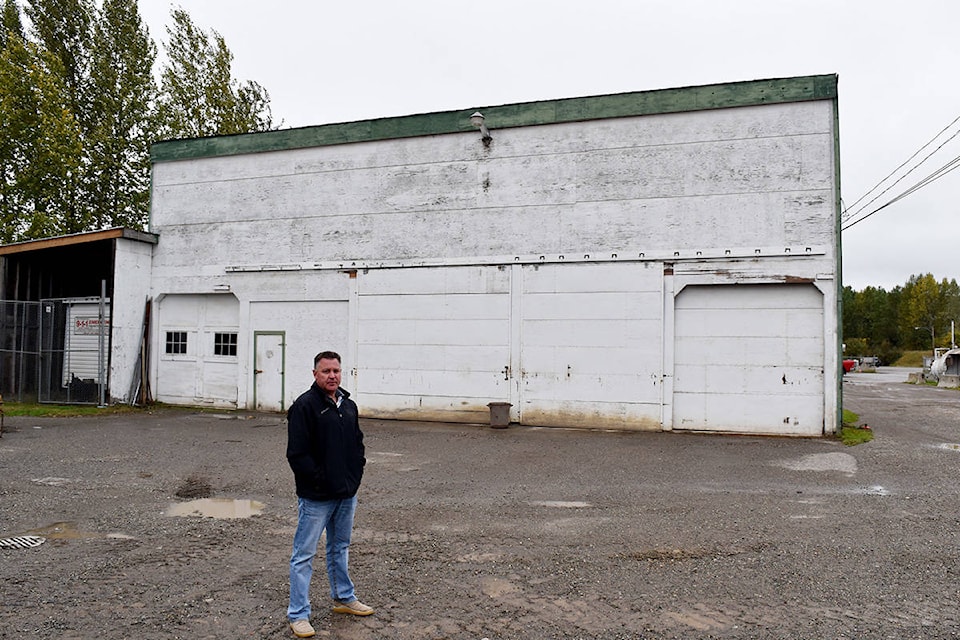Quesnel residents will be voting in a referendum on whether or not to allow the City to take out an $8.5 million loan to build a new Public Works facility in the October election.
The Public Works department is responsible for a variety of work around the city, including snow removal, road maintenance, water and sewer work, running and maintaining the landfill and cemeteries, as well as ongoing maintenance on the recreation centre and arena vehicles – and the list goes on.
Matt Thomas, the director of Public Works Operations, says the work done by the department is broad and varied.
In preparation for the referendum, the City of Quesnel hired an independent engineering company, West Edge Engineering, which is based out of Kamloops, to prepare a building condition assessment report on the current facility.
The Observer was also invited on a tour of the facility to learn more about the challenges it’s facing.
| With a lack of storage space, large, expensive tires and pipes must be stored outdoors. Heather Norman photo |
Employees tell stories of mice droppings on their desks, having to travel between buildings in the rain to print off papers or eat lunch, and leaky windows and doors, among other issues.
“It’s my understanding,” says Thomas, “that there’s air quality issues, there’s even lighting issues, things like that.” He says they do regular inspections to make sure things are running smoothly and safely but that challenges exist, especially with the older parts of the buildings.
The current Public Works facility is old, with two buildings built in the 1940s, and several more built between the 1960s and 1980s. The newest building is a trailer that was refurbished in 1998. It is currently the public office of the facility.
The public office also has accessibility issues. To enter the office, you must be physically able to climb up several stairs. And once you’re there, many of the washrooms are not considered ‘barrier-free accessible,’ according to the West Edge report.
| The machine shop only has one door, meaning work must be done on all the vehicles in the shop before the one at the back can be taken out. Behind the curtain, a welder works in the same room as mechanic. Heather Norman photo |
The West Edge report recommended that the Backhoe Bay, which stores backhoes and other expensive equipment, no longer be used. “The roof is disintegrating,” reads the report, “and there is general concern about safety.” The report also stated the building does not have the proper support system needed to provide stability. The building is still currently being used, however, as there is nowhere else to store the equipment.
The prognosis is not much better for the rest of the buildings in the facility. For most, the recommendation is that the buildings may be used short term, pending some safety upgrades, but any upgrades for long-term use are not recommended. The vast majority of the buildings in the facility, finds the report, are at the end of their lifespan.
READ MORE: Council taking new public works facility to referendum on Oct. 20, 2018
As can happen with old buildings, the Public Works facility was also found to contain asbestos — which can cause severe, long-term illnesses if inhaled or ingested, though is generally not considered harmful unless disturbed.
Other concerns in the report included entry and exit stairs that were not up to code, little to no insulation in buildings, and poor structural condition of floors and roofs.
The current facility is also highly susceptible to floods. When the Fraser River rises, says Thomas, it backs up the Quesnel river as well. “You know, we’re well below the 200-year flood plain here, and … at times, the water backs up because we’re so close to the river, and it floods out [both of] our yards. And then we have an evacuation plan in place for the yard to move all our equipment to the airport, so that we can still work and help with the flood repairs and all that kind of stuff.”
| The black line on the wall of the Utilities Office marks the 200 year flood plain against the height of the building. Heather Norman photo |
The main generator the facility runs on is also located well below the flood zone.
Beyond just the health and safety concerns, the facility, as it currently exists, has a number of inefficiencies. For example, Joe Law, the utilities superintendent with Public Works, says he simply doesn’t have the space to do his job efficiently. He needs three separate rooms to do his work with water, sewers and water sampling, but right now he only has one space for all of it.
“I need more storage space, I need more covered buildings for my equipment,” he says. Law says that not having those things means “inefficiencies, struggling to keep things clean.”
The proposed facility would be built on a city-owned property on Sword Avenue. The location is above the flood plain and would allow Public Works a quicker response time when it comes to floods.
The Public Works facility referendum will take place Oct. 20, at the same time as the municipal elections.
heather.norman@quesnelobserver.com
Like us on Facebook
